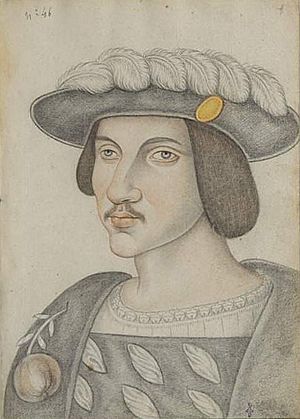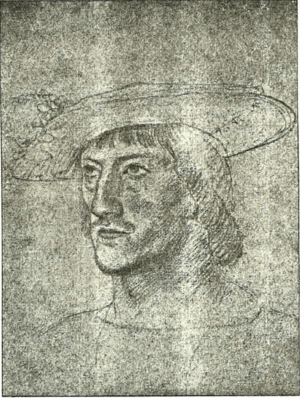Philibert of Chalon facts for kids
Quick facts for kids Philibert of Chalon, Prince of Orange |
|
|---|---|
 |
|
| Philibert of Chalon | |
| Reign | 18 March 1502 – 3 August 1530 |
| Predecessor | John II of Châlon |
| Successor | René of Chalon |
| Noble family | House of Chalon-Arlay |
| Father | John IV lord of Arlay |
| Mother | Philiberta of Luxembourg |
| Born | 18 March 1502 Nozeroy, Franche-Comté |
| Died | 3 August 1530 (aged 28) Outside Florence, Italy |
Philibert de Chalon (born March 18, 1502 – died August 3, 1530) was an important figure in European history. He was the very last Prince of Orange from the House of Chalon. This means he was the last ruler of the small but important Principality of Orange from his family line.
A Young Leader
Philibert was born in a place called Nozeroy. His father was John IV of Chalon-Arlay. From a young age, Philibert was involved in important events.
Fighting for the Emperor
Philibert became a commander for Emperor Charles V. An emperor was a very powerful ruler, like a king of many lands. Philibert fought for the Emperor in Italy during a big conflict known as the War of the League of Cognac. This was a time when different powerful groups in Europe were fighting for control.
He was part of the army that captured the city of Rome in 1527. Later, he was also involved in the Siege of Florence. A siege is when an army surrounds a city to try and take control of it. During this siege, Philibert and Emperor Charles V exchanged interesting letters, which we can still read today!
His Legacy
Philibert died in 1530 during the final battles outside Florence. He was the last male from his family line to be the Prince of Orange. After his death, his sister's son, Renatus of Nassau-Breda, became the next Prince of Orange. This was a very important moment because Renatus then started a new family line of rulers called the House of Orange-Nassau. This family later became very famous in European history.
See also
 In Spanish: Filiberto de Chalôns para niños
In Spanish: Filiberto de Chalôns para niños
Find Out More
- The Prince of Orange in Medieval History of Navarre


